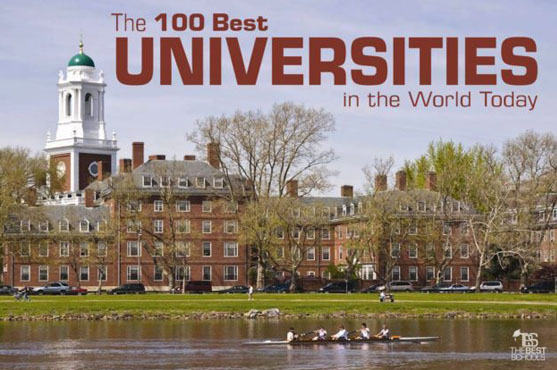University rankings can focus on many different factors, including attractiveness of campus, satisfaction of students and alums, extracurricular benefits (such as top athletics programs), affordability of tuition, and expected income of graduates.
But if the focus is on academic prestige, scholarly excellence, and intellectual horsepower, this article provides the ranking you want. At the universities in this ranking, you’ll be rubbing shoulders with the brightest faculty and students in the world, developing your knowledge and skills so that you yourself will be in a position to join the world’s elite academics, scientists, and thinkers.
For this ranking, we looked to the Center for World-Class Universities operated by Shanghai Jiao Tong University (left). This center specializes in ranking universities around the world by academic performance.
Accordingly, we identified the 100 best universities in the 2014 Academic Ranking of World Universities, better known as the “Shanghai Ranking.” Taking the Shanghai Ranking as our point of departure, we researched the most important characteristics of each of the top 100 universities on the list in order to reveal why each university appears where it does.
How do American universities stack up against the competition overseas? Next to each university in our ranking is the country where the university resides. The country that you’ll find overwhelmingly represented is the United States. Indeed, over half of the world’s hundred best universities (52 to be exact) are in the U.S.
As you scan this list, you’ll notice some interesting things. Of the top ten universities in the world, the top eight are in the United States. Most of the Ivy League schools are on the list. Also, most of the University of California campuses are on this list as well.
To assist our readers in seeing how American universities compare to themselves, we also include, in brackets, the relative rankings of U.S. universities.
The 100 Best Universities in the World
Here is the Top 10 .
1.Harvard University … [1st in U.S.]
 (Cambridge, MA, USA)
(Cambridge, MA, USA)
Harvard University is the standard by which all other research universities are measured. No school has ever challenged its position as the world’s premier academic institution in the history of the Shanghai rankings.
Founded in 1636 (only 16 years after the Mayflower touched down at Plymouth Rock), Harvard is the oldest school in the world’s richest nation, and it has capitalized on the benefits this grants. Under manager Jack Meyer’s leadership, the school’s endowment fund grew from $4.6 billion to $25.8 billion in 15 years. Today, the university possesses over $36 billion, and its fortune is still growing.
But there is much more to Harvard than massive wealth. The school has produced 47 Nobel Laureates, 32 heads of state, and 48 Pulitzer Prize winners. It boasts the largest academic library in the world (Widener Library, home to some 6 million volumes), as well as leading medical, law, and business schools. It has an integrated alumni network that stretches around the globe.
It would be invidious to single out any of Harvard’s many academic departments for its excellence, for the school’s principal claim on the #1 position lies in the fact that it is at or very near the top in nearly every field across the entire spectrum of the sciences and the humanities!
Not only is Harvard dominant across a multitude of academic fields, it is also ideally situated to work alongside a variety of other schools. The most obvious example is MIT, but the greater Boston metropolitan area is also home to Boston College, Boston University, Northeastern, Tufts, Brandeis, and several other research universities. This fact equips both students and faculty with endless opportunities for collaborative research.
2.Stanford University … [2nd in U.S.]
 (Stanford, CA, USA)
(Stanford, CA, USA)
With an $18.7 billion endowment Stanford has access to numerous world-class research resources.
The school’s 1,189 acre Jasper Ridge Biological Preserve lets scientists study ecosystems first hand. Its 150-foot radio telescope, nicknamed “The Dish,” studies the ionosphere.
Stanford also boasts a 315-acre habitat reserve which is actively trying to bring back the endangered California tiger salamander. And the SLAC Accelerator Laboratory actively advances the U.S. Department of Energy’s research.
Stanford is also affiliated with the prestigious Hoover Institution, which is one of the nation’s leading social, political, and economic think tanks.
But it takes more than just great laboratories and facilities to build a great research center. Stanford also has some of the finest minds in the world working for it. The school’s faculty currently include 22 Nobel Laureates, 51 members of the American Philosophical Society, three Presidential Medal of Freedom recipients, 158 National Academy of Science members, five Pulitzer Prize winners, and 27 MacArthur Fellows.
3. Massachusetts Institute of Technology (MIT) … [3rd in U.S.]
 (Cambridge, MA, USA)
(Cambridge, MA, USA)
In the century and a half since its founding in 1861, MIT has become the world’s preeminent science research center.
The university is known for a focused approach that uses first-class methodologies to tackle world-class problems. This pragmatic creativity has produced legions of scientists and engineers, as well as 80 Nobel Laureates, 56 National Medal of Science winners, 43 MacArthur Fellows, and 28 National Medal of Technology and Innovation winners.
Nevertheless, the school’s more than $10 billion endowment still leaves plenty of room for the arts and humanities. This is why MIT Press can publish 30 prestigious journals and 220 state-of-the-art books every year. Since 1899, MIT Technology Review has continuously researched developing trends in the industrial sciences and other related fields, making their publications essential for anyone trying to understand where future innovation is headed.
Notable people affiliated with MIT include Apollo 11 astronaut Buzz Aldrin, father of linguistics Noam Chomsky, former U.N. Secretary General Kofi Annan, and former Federal Reserve Chairman Ben Bernanke.
4.University of California at Berkeley … [4th in U.S.]
 (Berkeley, CA, USA)
(Berkeley, CA, USA)
Berkeley is unique among the elite universities of the world. Most of the schools it competes with are privately owned, but Berkeley is a state school—albeit one with the elite status of a private school.
The university is nestled in a pleasant city by the same name, within easy commuting distance of San Francisco. With over 36,000 students, Berkeley is also one of the larger elite universities.
An impressive selection of talented students feeds its over 350 degree programs, producing more Ph.D.’s annually than any other U.S. institution. Student research is encouraged as each year 52 percent of seniors assist their professors in their research.
Berkeley draws students from over 100 nations. During the previous decade the National Science Foundation granted its students more graduate research fellowships than any other school.
The faculty has produced 39 members of the American Philosophical Society, 77 Fulbright Scholars, 32 MacArthur Fellows, and 22 Nobel Laureates (eight of whom are current faculty members).
5. University of Cambridge
 (Cambridge, UK)
(Cambridge, UK)
As one of the oldest universities in the world (founded in 1209), Cambridge is an ancient school steeped in tradition.
It is small exaggeration to say the history of western science is built on a cornerstone called Cambridge. The roster of great scientists and mathematicians associated with the university includes Francis Bacon, Isaac Newton, Charles Darwin, James Clerk Maxwell, Augustus De Morgan, Ernest Rutherford, G.H. Hardy, Srinivasa Ramanujan, Alan Turing, Francis Crick, James Watson, Roger Penrose, and Stephen Hawking. Whether speaking of the unifying ideas in physics, the foundations of computer science, or the codifying of biology, Cambridge has been at the forefront of humanity’s quest for truth longer than most nations have existed.
Of course, great achievements are not restricted to the sciences. Such luminaries in the humanities as Desiderius Erasmus, John Milton, G.E. Moore, Bertrand Russell, Ludwig Wittgenstein, John Maynard Keynes, and C.S. Lewis, among dozens of other great names, taught and studied here.
But despite the many memories conjured by its imposing Gothic architecture, Cambridge does not live in the past. The university remains one of the world’s elite research institutions, with only Oxford to rival it in the U.K. and only a handful of American schools able to do so from overseas.
Its over 18,000 students represent more than 135 countries and its faculty have earned over 80 Nobel laureates.
6. Princeton University … [5th in U.S.]
 (Princeton, NJ, USA)
(Princeton, NJ, USA)
Princeton University is one of the oldest, most historic universities in the United States. Its famous Nassau Hall (right) still bears a cannonball scar from the 1777 Battle of Princeton, and its former president, John Witherspoon, was the only University president to sign the Declaration of Independence.
The school’s nearly three-century history has given it ample time to develop an impressive $18.2 billion endowment. But unlike the other big institutions it competes with—such as Yale, Harvard, and Stanford—Princeton spreads its considerable wealth across a far smaller number of students and programs.
Princeton has no law school, medical school, business school, or divinity school. Instead of developing professional programs, it has self-consciously evolved into a massive, research-driven think tank.
Whereas other schools typically direct their elite faculties’ attention towards graduate students, Princeton expects its professors to teach students of various academic levels. Furthermore, Princeton, more so than many other leading institutions, continues to challenge its students with a difficult grading scale. Even brilliant valedictorians who come here from around the country find that they need to focus on their studies.
7. California Institute of Technology (Caltech) … [6th in U.S.]
 (Pasadena, CA, USA)
(Pasadena, CA, USA)
Any school can assign a textbook for you to read on your own, but research universities pride themselves on giving you the opportunity to work alongside leaders in their respective fields who write the textbooks.
Of course, in order to do this efficiently a school needs a decent student/faculty ratio. Few schools can beat Caltech’s three-to-one ratio—which is one of the many reasons why this relatively young school has risen to international prominence.
Its faculty includes 33 Nobel Laureates, 58 National Medal of Science recipients, 13 National Medal of Technology and Innovation recipients, and 111 National Academy of Science members.
But to gain access to this prestigious collection of brilliant professors you will have to be the best of the best. Six thousand six hundred twenty-five applicants compete to be one of the 226 members of the freshman class—which is why 98 percent of the student body graduated in the top 10 percent of their class.
These students and teachers can also study at some of the school’s world-famous research centers, such as the Jet Propulsion Laboratory, the Seismological Laboratory, and the International Observatory Network.
8. Columbia University … [7th in U.S.]
 (New York, NY, USA)
(New York, NY, USA)
As one of the colonial colleges and the fifth-oldest school in the United States, Columbia has a lot of history. That history has created an internationally recognized, elite university with an $8.2 billion endowment and a library containing nearly 13 million volumes.
Columbia University is spread across five distinct campuses in New York City, including Columbia College, the undergraduate division. In 2013, 26,376 students applied for 1,751 admittances to Columbia College.
The university’s medical school—the College of Physicians and Surgeons, which was founded in 1767—produced the first M.D.’s in the 13 colonies. The school now graduates nearly 1,400 doctors per year.
Columbia is the leading university in the New York metropolitan area, which gives its students numerous unique opportunities that only proximity to Wall Street, the U.N., Broadway, and other epicenters of finance, politics, and culture can bring. The university’s ideal location also gives its students the chance to interact with various other respected institutions, such as New York University.
Eighty-two Columbians have won a Nobel Prize at some point in their careers.
9.University of Chicago … [8th in U.S.]
 (Chicago, IL, USA)
(Chicago, IL, USA)
The University of Chicago was only founded in 1890, making it one of the youngest elite universities in the world. But despite its youth, the school has spearheaded many of the world’s most important scientific achievements.
It was here that Italian physicist Enrico Fermi created the world’s first controlled, self-sustaining nuclear chain reaction in 1942. It was likewise at Chicago that Stanley Miller and Harold Urey demonstrated in 1952 that amino acids essential to life could be produced starting from simple molecules such as methane and ammonia, thus founding the entire field of what has come to be known as “origin of life” research. Today, the university is one of the leading universities building on the work of its famous alum, James Watson, in the exploration of the human genome.
But Chicago is not just a science school. It also possesses great depth, with elite programs in the humanities and the social sciences, including its world-renowned Economics Department and its interdisciplinary gathering of highly distinguished thinkers known as the Committee on Social Thought.
Of Chicago’s 89 Nobel Prize winners, 22 have been in economics, which is remarkable given that the economics prize was only first awarded in 1969 (45 years ago at the time of this writing). Perhaps this is one reason why the university weathered the 2008 financial crisis relatively well!
In any case, the school’s approximately $7 billion endowment is now rapidly growing once more, assuring the continuation of the ample research opportunities it provides its faculty and students well into the future.
10.Oxford University
 (Oxford, UK)
(Oxford, UK)
Oxford University traces its origins back to the 13th century. With its intellectual roots firmly planted in medieval scholasticism, Oxford has survived the centuries, adapted to the times, and grown into what it is today—one of the world’s most impressive centers of learning.
Perhaps more than any other school in the world, Oxford’s name has become synonymous with knowledge and learning. This is because the school runs the world’s largest—and arguably most prestigious—academic press, with offices in over 50 countries.
One in five people who learn English worldwide do so with Oxford University Press materials. This international appeal may explain why almost 40 percent of the student body comes from outside the U.K.
Oxford’s academic community includes 80 Fellows of the Royal Society and 100 Fellows of the British Academy. Over 17,200 people applied for 3,200 undergraduate places in 2014.
However, despite thousands of undergraduate students willing to pay full tuition and centuries of accumulated assets, the highest source of income for Oxford continues to be research grants and contracts.
Source: http://www.thebestschools.org/features/100-best-universities-in-world-today/


